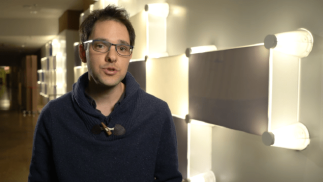Topological and chiral lasing in micro-resonator arrays
Presentation given in English
Philippe St-Jean
Centre de Nanosciences et de Nanotechnologies
CNRS - Université Paris-Sud, Université Paris-Saclay, France
Abstract: Engineering non-trivial symmetries in photonic structures is a very promising avenue for developing new generations of optical devices presenting exotic yet technologically relevant assets, e.g. topological protection [1] and chiral transport of light [2]. In this context, arrays of coupled semiconductor micro-resonators are particularly advantageous, because (1) they allow engineering well-defined potential landscapes for photons [3], and (2) embedded quantum wells in these structures can provide optical gain. In this presentation, I will show how these advantages of micro-resonator arrays can be harnessed for developing laser sources where the architecture of the cavity gives rise to resonating modes exhibiting genuinely novel properties.
In the first part of the presentation, I will show how we took profit of these advantages to demonstrate the first realization of a topological laser [4], i.e. a laser where the resonating mode is intrinsically protected against external perturbations by the underlying topology of its architecture. To do so, we implemented a 1-dimensional micro-resonator array that exhibits well-defined topological properties leading to the emergence of robust edge states. Then, using the gain provided by the embedded quantum wells, we triggered lasing in one of these topological edge states, and demonstrated the immunity of this lasing action against optically-induced perturbations.
Then, I will present a recent work [5] where we used hexagonal molecules of coupled micro-resonators to trigger lasing in a mode carrying a well-defined and optically tunable orbital angular momentum (OAM). OAM is an unbounded degree of freedom of light associated to phase vortices in helical wavefronts. Such an unbounded Hilbert space appears extremely advantageous in many technologically relevant areas, such as classical and quantum information encoding, optical manipulation and optomechanics. In this work, we developed a novel scheme based on the spin-orbit interaction of photons in these hexagonal molecules to demonstrate, for the first time in a fully integrated device, the optical control of the chirality of a lasing mode (i.e. carrying either a clockwise or counter-clockwise phase twist). Our results thus pave the way to the development of ambitious protocols, e.g. in quantum cryptography, based on the ultrafast control of OAM.
References:
[1] L. Lu. et al.. Nat. Photon. 8, 821 (2014); T. Ozawz et al. arXiv: 1802.04173v1 (2018)
[2] P. Lodahl et al. Nature 541, 473 (2017)
[3] M. Milicevic et al. Phys. Rev. Lett. 118, 107403 (2017); F. Baboux et al. Phys. Rev. B 95, 161114 (R) (2017)
[4] P. St-Jean et al. Nat. Photon. 11, 651 (2017)
[5] N. Carlon Zambon, P. St-Jean et al. arXiv:1806.04590 (2018)
Philippe St-Jean is a postdoc researcher in the group of Jacqueline Bloch, a CNRS research center based in Paris, France.
Cette conférence est présentée par le RQMP Versant Nord du Département de physique de l'Université de Montréal et de Génie physique de la Polytechnique.

